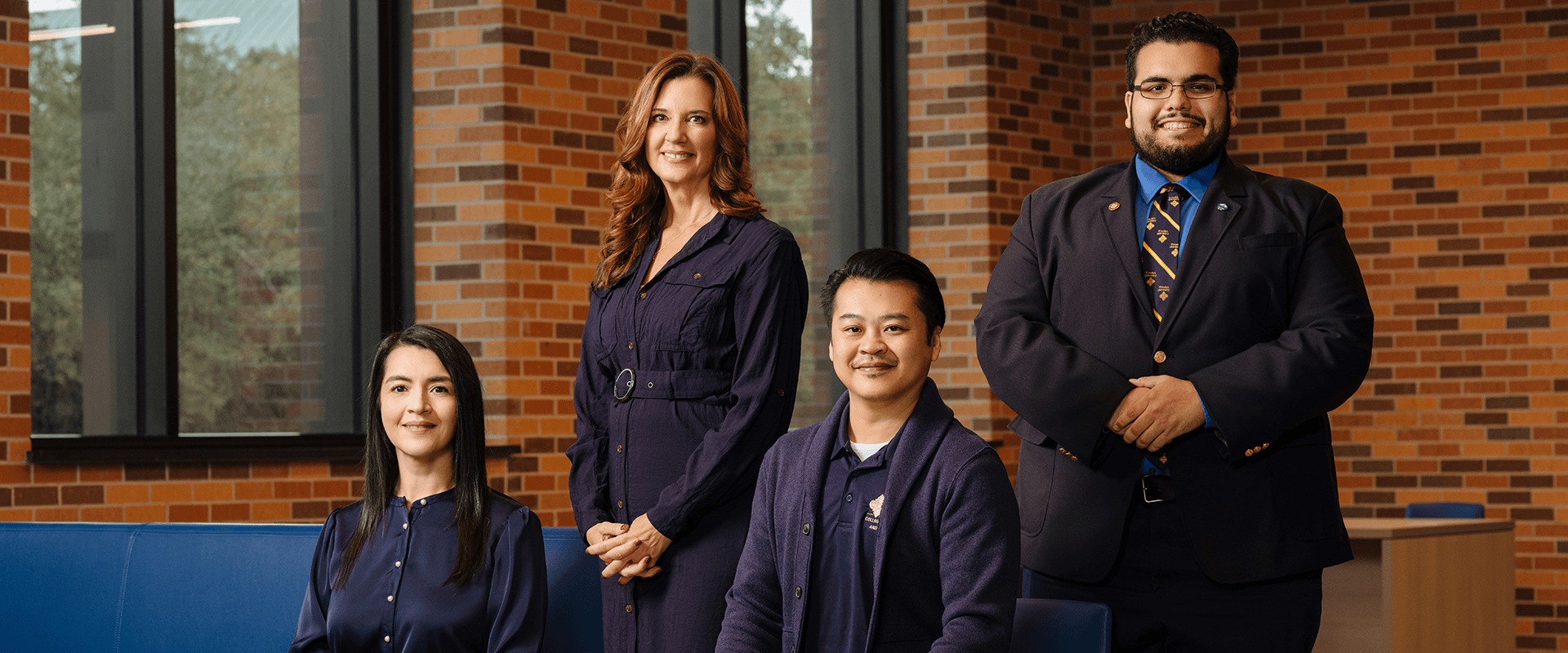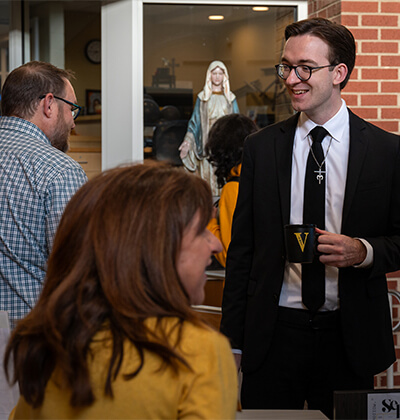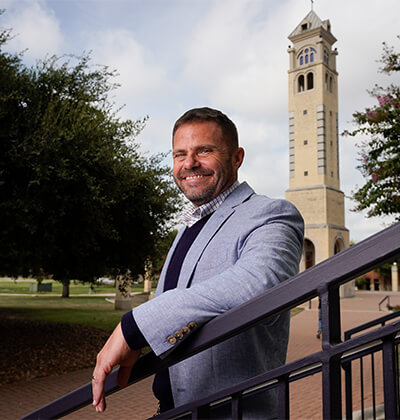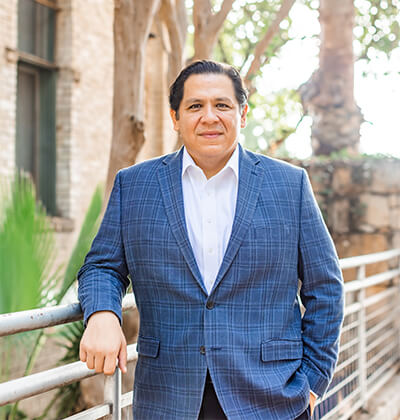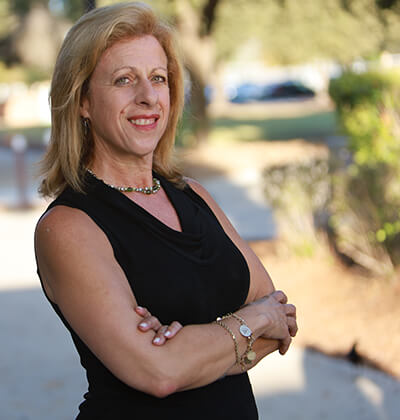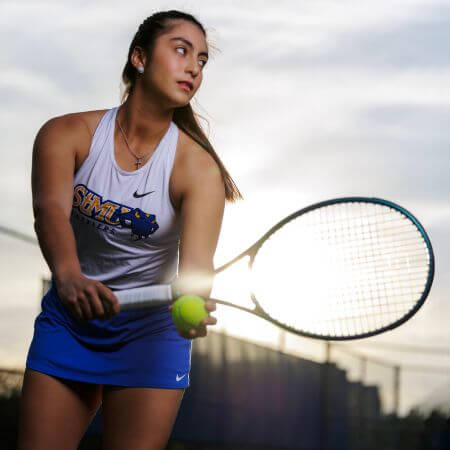Holistic health
by Nathaniel Miller
For two years, Pecan Grove was partially consumed as construction crews came and went, carrying beams, bricks, glass panes and more.
When the dust cleared, the School of Science, Engineering and Technology’s newest addition — the Blank Sheppard Innovation Center — was complete.
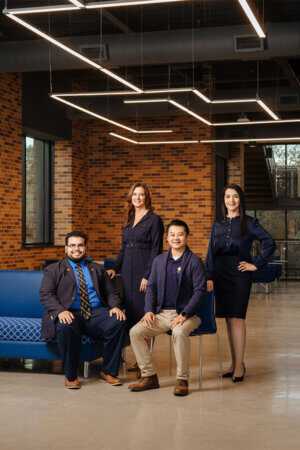
Heralded as a truly intradisciplinary space, the state-of-the-art jewel is where science and other fields come together to educate St. Mary’s University students.
“Within these walls, our students will have unparalleled opportunities to engage in hands-on learning, cutting-edge research and interdisciplinary problem-solving,” said School of Science, Engineering and Technology Dean Teresa “Teri” Beam, Ph.D.
Serving as that symbol of unity between health and the liberal arts, the Blank Sheppard Innovation Center contains a third-floor home for the University’s new Bachelor of Science in Nursing Program as well as interdisciplinary spaces throughout, which may be used by various professors and students.
These facilities are a potential boon for new or recrafted programs, such as Public Health, Medical Humanities, and Exercise and Sport Science. The renewed focus on health education also highlights existing partnerships between St. Mary’s and multiple medical schools offering acceptance pathways to pre-med students.
“At St. Mary’s, we understand that modern health care is a symphony, not a solo performance,” Beam said. “Our Nursing Program deliberately trains students to be both skilled soloists and collaborative team players.
We teach them that their expertise, while crucial, gains its full healing potential when harmonized with other health care specialists.”
Creating future nurses is not the only way St. Mary’s is preparing its students to care for the public.
Medical professionals do much more than see patients, they also create programs and equipment (such as phone apps). People in these roles are just as essential to health care as a doctor.
Academically, this focus on health care as a team sport will continue the University’s long-standing status of creating innovative servant leaders.
“By building out this suite of health-focused degrees, we’re providing students with new academic and career options, as well as fostering synergistic research collaborations across campus,” said Jason Pierce, Ph.D., Provost and Executive Vice President for Academic Affairs.
The holistic approach also applies to life on campus. Changes to the Student Health and Wellness Programs offer a variety of options to students — from counseling to a food pantry focused on combating food insecurity.
Through education and practice, the lessons learned at St. Mary’s eventually travel with students and graduates back home.
“The programs that we have launched will help our graduates help their communities through direct patient care, health care advocacy, education and policy,” said St. Mary’s University President Winston Erevelles, Ph.D.
Going Beyond Physical Care
Donna Badowski, D.N.P., never anticipated leaving Chicago, much less helping start a nursing program.
With 15 years of experience teaching nursing, including time as an Associate Professor and Associate Director at DePaul University, Badowski took a chance when applying at St. Mary’s.
“Throughout the whole process, I felt like God was pointing me on this journey,” said Badowski, now Vice Dean and Founding Director of Nursing at St. Mary’s.
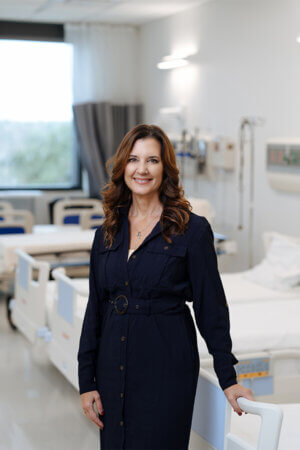
Forty St. Mary’s pre-nursing students began their own journey in Fall 2024, striving to become part of the Nursing Program’s first cohort.
Those same students will still need to apply to the Nursing Program by March 2025. If selected, they will begin as Nursing majors in Fall 2025. New pre-nursing students will be accepted each fall.
St. Mary’s received approval for the program from the Texas Board of Nursing in January 2024 and from the Southern Association of Colleges and Schools Commission on Colleges (SACSCOC) in March 2024.
Each cohort will be capped at 35 students until the inaugural cohort graduates, takes the National Council Licensure Examination (NCLEX) and achieves an 80% pass rate.
Working closely with professors in the prerequisite courses, Badowski said students are encouraged to seek academic assistance and meet with other pre-nursing members to build a strong community.
“There are four areas we want to target with this program: engagement, success, community and service,” she said.
Nursing courses begin the second year of the four-year program and include skills labs (where students practice giving injections and performing blood draws), simulations (working with life-like manikins in various settings) and clinicals in local hospitals and other facilities.
The St. Mary’s curriculum focuses on viewing patients as people, not diagnoses, Badowski said.
“Mental health affects everybody, so we thought our students need to have a good understanding of that so they can carry that knowledge throughout the curriculum,” she said.
The need for nurses in Texas alone justifies a Nursing Program at St. Mary’s.
The Texas Center for Nursing Workforce Studies projects a labor deficit of 57,012 registered nurses in Texas by 2032. The numbers state the South Texas region will need 2,417 registered nurses, and the Rio Grande Valley area will need 6,274.
Erevelles said it has always made sense for St. Mary’s to offer Nursing, and is happy to see the excitement around it.
“Between our Catholic identity, Marianist charism, our liberal arts background and the strong pre-health programs, we can keep finding ways to better serve our community,” he said.
Navigating Health Care
St. Mary’s also offers educational opportunities for those interested in the medical field but do not aspire to provide hands-on health care services.
Some want to make a difference by becoming community health workers, helping people more easily access medical services. Others may want to make communication more efficient or design a system that makes paperwork easier to complete.

Health care is more than just doctors and nurses. Caring for others does not always require knowledge of medicine.
Already offering a Certificate in Public Health, St. Mary’s has expanded that course of study to offer a Bachelor of Science in Public Health. Public health is the science of protecting and improving the health of people and their communities through promoting healthy lifestyles and researching disease and injury prevention.
“Public Health is a broad field,” said Janet Armitage, Ph.D. (M.B.A. ’21), St. Mary’s Professor of Sociology and Director of Public Health Programs. “All these practitioners and professionals in these different career options are pulling toward the same holistic care.”
The new degree offers four tracks: Generalist, Health Informatics, Health Care Compliance and an accelerated Master of Public Health.
Graduates with Public Health degrees can work in areas such as epidemiology, handling electronic health records and helping people navigate the U.S. health care system. An example of public health work would be updating the Centers for Disease Control and Prevention website with new information.
Armitage called public health a truly interdisciplinary field. The COVID-19 pandemic helped the public better understand how many people work in or with health care.
“You realize, ‘I could be an accountant and be in health care,’ or ‘I could be a public health advocate liaison,’ ” Armitage said. “Many students are realizing that this is something they can do.”

The School of Law, in collaboration with UTHealth Houston School of Public Health, recently unveiled two new joint degrees: a Doctor of Jurisprudence and a Master of Public Health (J.D./M.P.H.), and a Master of Jurisprudence and Master of Public Health (M.Jur./M.P.H.).
While a J.D. degree is required for practicing law in most states, an M.Jur. is tailored toward students who will not become lawyers but want to gain a deeper understanding of legal concepts.
Both joint degrees are designed to help navigate and understand the complexity of medical law.
Additionally, a Bachelor of Arts in Medical Humanities and a minor in Medical Humanities will launch Fall 2025. The new major will have two tracks: a Health Humanities Track for students interested in patient advocacy, law or nonprofit work; and a Health Care Management Track
for students interested in administration
and management.
“The new Bachelor of Arts in Medical Humanities exemplifies St. Mary’s commitment to educating compassionate and ethical leaders,” said Benjamin “Josh” Doty, Ph.D., Chair of the Department of English Literature and Language, and who will oversee the Medical Humanities program. “By putting health care into conversation with the humanities, this program equips students to make a lasting impact in the health care industry in service to others.”
Improving Human Performance
Sometimes, it’s good to flex more than just your brain.
Focusing on the effects of exercise on the body, the St. Mary’s Exercise and Sport Science Program, originally a Bachelor of Arts, added two new tracks leading to a Bachelor of Science — a Generalist Track and a Pre-Physical Therapy Track.
Exercise and Sport Science focuses on how the human body responds to exercise.
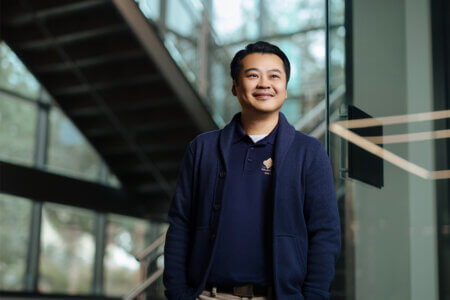
While the latter allows students to easily apply for continued education to become physical or occupational therapists, the General Track focuses on overall exercise and body correlation.
“If you look at the number of people interested in becoming physical and occupational therapists, you can see these jobs are for more than just pre-med students,” said Kelvin Wu, Ph.D., Associate Professor of Exercise and Sport Science.
The Bachelor of Arts in Exercise and Sport Science with Teacher Certification is still available for students whose goal is coaching alongside teaching.
New equipment purchased through the Title V Base Grant has helped create the Human Performance Lab, adding a lab component to some classes. One item purchased, a VO2 Max Testing System, measures the amount of oxygen the body uses during exercise.
The importance of exercise is well known. In the U.S., all states have an obesity prevalence greater than 20%, according to 2023 numbers from the Centers for Disease Control and Prevention. The organization recommends 150 minutes of moderate to intense exercise weekly.
“We are preparing our students to help people who are willing to lose weight, who are willing to change their lifestyles and who are willing to change their behavior to fit the healthy standards,” Wu said.
Focusing on Self-Care
Talking about mental health is still considered taboo for some, acknowledged Vanessa Peña, Ph.D. (B.S. ’04), Executive Director of Student Health and Wellness Programs. However, since the COVID-19 pandemic, many people have changed their outlook.
In a 2024 poll, the American Psychological Association reported that 43% of adults feel more anxious than they did in 2023. The same poll also showed current college students are more than twice as likely than previous generations to seek mental health care.
To make the Student Counseling Center more accessible, Peña has been finding ways to improve student services.
“In the Counseling Center, the biggest resource we have is time, so we are making sure that we’re efficient and judicial with what we do with our clinical time,” Peña said.
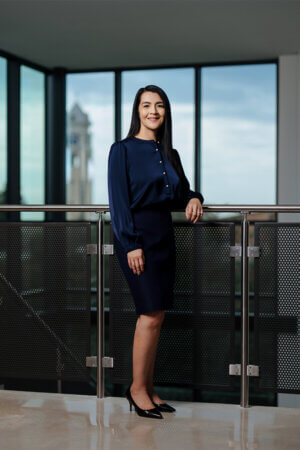
To cut down on waiting times, the Student Counseling Center changed to a short-term model — where finding solutions to current issues is the focus.
Students feeling anxiety, stress or depression can meet with a counselor free of cost, and discuss their concerns, coping strategies and developing healthy habits.
“The short-term model is about learning what the student is experiencing and then making a recommendation for what makes the most sense for them,” Peña said. “We always make sure that they’re connected to resources. If students are in some sort of mental health crisis, we’re going to continue seeing them until they can get connected to a long-term provider.”
Staff members work in a rotating shift, taking turns counseling walk-ins and meeting with new students seeking treatment.
The Rattler Helpline, a 24-hour phone line for all enrolled students, is also available for students. Peña and her team have also engaged the University community to promote Wellness Programs.
“Everything we do is along one of the eight dimensions of wellness and that includes mental health,” Peña said. “We’re helping students strive to be the best versions of themselves.”
The St. Mary’s Medical Pipeline
Francisco Garcia will happily tell you he did well on his Medical College Admissions Test (MCAT) with little stress.
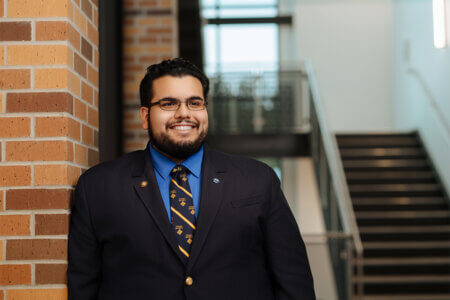
Garcia said his education at St. Mary’s was the best way he could think of to prepare.
“When I went into that MCAT exam the quality of the education I received at St. Mary’s enabled me to succeed,” Garcia said.
Because of his outstanding academic achievements at the University, Garcia was accepted into the Baylor College of Medicine Early Acceptance Program.
Announced in 2020, St. Mary’s and Baylor College of Medicine teamed up to give students an opportunity to gain early acceptance to the Baylor College of Medicine during their second year of undergraduate study at St. Mary’s. Students must maintain good academic standing and maintain a semester and cumulative GPA of at least 3.5, score at least 502 on the MCAT, complete a summer internship after sophomore year, and receive satisfactory evaluations from the Baylor staff.
Garcia is scheduled to graduate from St. Mary’s in Spring 2025.
The University has a long history of preparing sought-after pre-med students, with 884 St. Mary’s undergraduates being accepted into a medical or dental program since 1980.
The quality of students has not gone unnoticed. St. Mary’s also partners with the Saint Louis University School of Medicine to offer the Father Jim Tobin SLU Pre-Medical Scholars Program.
Gordon Schutze, M.D.“Mentoring is about giving people the opportunity to achieve their goals and dreams. For me, that began at St. Mary’s.”
Agreements also exist with the Lake Erie College of Osteopathic Medicine, UTHealth San Antonio School of Dentistry and the University of the Incarnate Word Feik School of Pharmacy.
The Joint Admission Medical Program (JAMP), created by the Texas Legislature to support highly qualified, economically disadvantaged Texas resident students pursuing a medical education, is another avenue for pre-med students.
When serving as a tour guide on campus, Garcia said he makes it a point to emphasize what St. Mary’s offers for students interested in
medical careers.
“I’m always telling anyone who wants to apply for this kind of program everything they need to know,” he said. “I’m a big fan of sharing the wealth among students to help them know what needs to get done.”
The benefits of mentorship have not changed at St. Mary’s, even when technology has.
Gordon Schutze, M.D. (B.S. ’80), St. Mary’s Trustee and Vice Dean of the School of Medicine at Baylor College of Medicine, described the medical field as a team sport. He added that mentorship is a huge component in helping students reach their potential.
“I’m a graduate of St Mary’s and so anytime somebody from St. Mary’s succeeds, I feel very proud,” Schutze said.
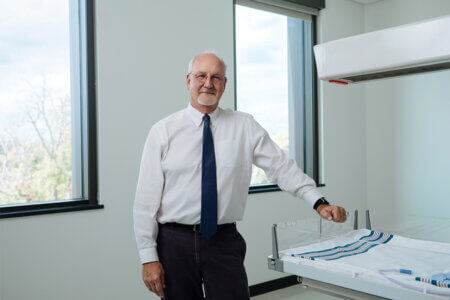
The Baytown native found himself learning about mentorship from Rosemarie Wahl, Ph.D., Professor Emerita of Biological Sciences. Being picked as a student to work alongside her in labs, Schutze has helped recreate those moments for other students throughout his career.
Today’s students will get to study in the Blank Sheppard Innovation Center, a state-of-the-art, 30,000-square-foot building housing new laboratories, collaboration spaces and programs focusing on advanced manufacturing, instrumentation, data science, machine learning and more.
Its top floor, which benefited from a gift from the IBC Foundation, includes high-fidelity patient simulators, realistic hospital settings and advanced medical equipment.
University Health, partners in the St. Mary’s Nursing Advisory Council, also donated 12 beds to the facility, giving students the opportunity to work in a life-like simulation space.
Schutze said adding faculty, such as Assistant Professor of Biological Sciences Benjamin Enslow, M.D., who helps counsel pre-med students, makes the University the best place to learn about caring for the whole person, especially in the new Blank Sheppard Innovation Center.
“Mentoring is about giving people the opportunity to achieve their goals and dreams,” Schutze said. “For me, that began at St. Mary’s.”

